
The besra, also called the besra sparrowhawk is a bird of prey in the family Accipitridae.

Cynodon is a genus of plants in the grass family. It is native to warm temperate to tropical regions of the Old World, as well as being cultivated and naturalized in the New World and on many oceanic islands.

Pseudanthus is a genus of plants under the family Picrodendraceae. The genus is endemic to Australia described as a genus in 1827.

The striped laughingthrush is a species of bird in the family Leiothrichidae.
The perplexing scrubwren is a bird species. Placed in the family Pardalotidae in the Sibley-Ahlquist taxonomy, this has met with opposition and indeed is now known to be wrong; they rather belong to the independent family Acanthizidae.
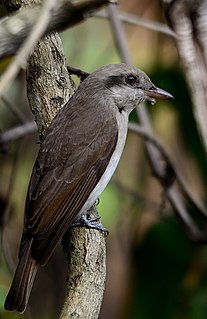
The large woodshrike is found in south-eastern Asia, Sumatra, Java, and Borneo. Its natural habitats are temperate forest, subtropical or tropical moist lowland forest, subtropical or tropical mangrove forest, and subtropical or tropical moist montane forest.
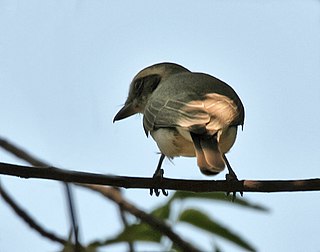
Tephrodornis is a bird genus usually placed in the Vangidae.
Protomelas virgatus is a species of cichlid endemic to Lake Malawi. This species can reach a length of 14 centimetres (5.5 in) SL. It can also be found in the aquarium trade.
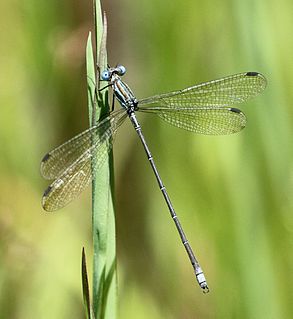
Lestes virgatus is a species of damselfly in the family Lestidae, the spreadwings. It is known commonly as the smoky spreadwing and virginal spreadwing. It is native to much of southeastern Africa, where it is widespread. It lives in pools and swamps in forest and woodland habitat.

Nemipterus virgatus, the golden threadfin bream, is a species of threadfin bream native to the western Pacific, from southern Japan south to northwest Australia including the Arafura Sea. It inhabits areas with mud or sand substrates and the young can be found at depths from 18 to 33 m while the adults can be found down to 220 m (720 ft). This species can reach a length of 35 cm (14 in), though most are only around 23 cm (9.1 in). It is one of the most important species of commercial fisheries in the East China Sea and northern South China Sea.

Cryptoblepharus virgatus, also commonly known as striped snake-eyed skink, cream-striped shining-skink, wall skink, fence skink or snake-eyed skink is a skink commonly found in southern and eastern Australia. It is an active little lizard, and if threatened will often play dead to confuse the attacker.

Parepisparis virgatus is a species of moth of the family Geometridae. It is found in Australia.
Propalticidae is a family of beetles, in the suborder Polyphaga. It contains two genera with the following species:

Conus virgatus, common name the virgate Panama cone, is a species of sea snail, a marine gastropod mollusk in the family Conidae, the cone snails and their allies.
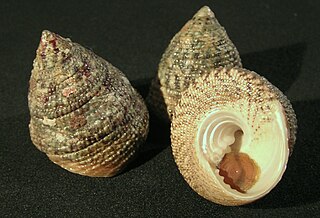
Tectus virgatus, common name the striped top shell, is a species of sea snail, a marine gastropod mollusk in the family Tegulidae.
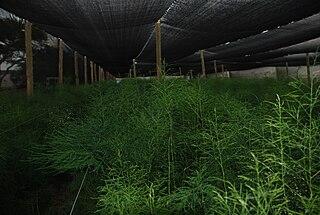
Asparagus virgatus is a plant indigenous to South Eastern Africa. It is also known as tree fern, tiki fern, and African broom fern. Asparagus virgatus is a member of the genus Asparagus, and not a true fern.

Eurema floricola, the Malagasy grass yellow, is a butterfly in the family Pieridae. It is found in Sierra Leone, Ivory Coast, Ghana, Nigeria, the Democratic Republic of Congo, Burundi, Kenya, Tanzania, Zambia and on Madagascar, the Comoros, Mauritius, Réunion and the Seychelles. The habitat consists of the forest/savanna transition zone.

Desmanthus virgatus is a species of flowering plant in the legume family that is known by many common names, including wild tantan, prostrate bundleflower, dwarf koa, desmanto, acacia courant, acacia savane, pompon blank, adormidera, brusca prieta, frijolillo, ground tamarind, guajillo, guashillo, huarangillo, langalet, petit acacia, petit cassie, petit mimosa, virgate mimosa, and slender mimosa, as well as simply desmanthus. It is native to the American tropics and subtropics but is present elsewhere as an introduced species. In some areas it is cultivated as a fodder and forage crop.
Macrocamptus andamanicus is a species of beetle in the family Cerambycidae. It was described by Gardner in 1930.

Homoranthus virgatus is a plant in the myrtle family Myrtaceae and is endemic to coastal areas of northern New South Wales. It is an upright shrub with wand-like branches.
















